skip to main |
skip to sidebar
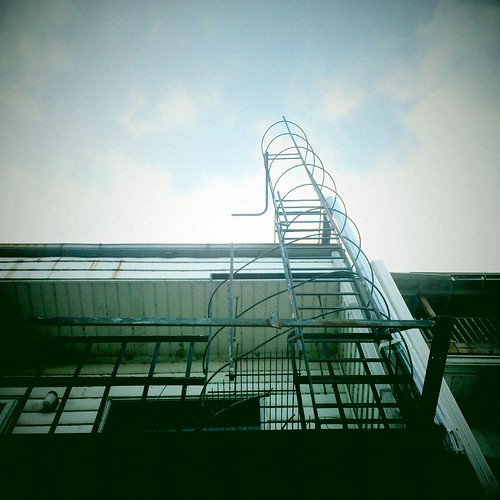
© 2010 Simon Hucko
Only 4 entries this week... Where did everyone go? Even if you can't get out for a "serious photoshoot," try to keep a camera near at hand and capture those little everyday moments. If you're anything like me, you see photos all around you all the time. Make the extra effort to carry a camera with you and stop at least once a day when you see one of those photos. You can do it!
Life has been crazy busy for me lately, so I'm happy to have my camera phone to fall back on. It's very freeing to walk around with my phone armed with a slew of lomo processing filters capturing interesting sights around me. This week's photo is the result of looking up. I'm always amazed at what I see when I look up at the world above me, and the fresh perspective and subject matter usually lends itself to good photos. This week's photo also takes advantage of leading lines, since the strong lines from the building and fire escape lead you right into the middle of the photo.
My pick this week is "Yellowed" by slithy-toves:
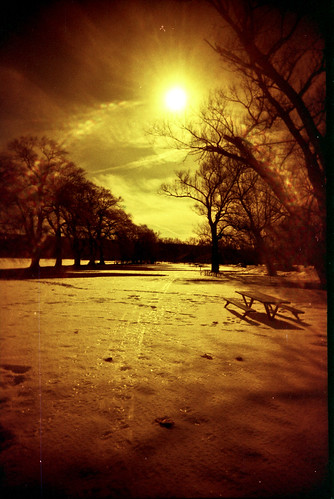
© slithy-toves
Technically it's cheating, since she didn't take the photo last week, but I'm going to let it slide. I love the result from the redscale film here - the yellow/orange/red tones are just fantastic. I like the heavy vignette and the contrasty shadows that she got here, too, and the way the trees reach in at the top and frame the sun. My absolute favorite part of the image, though, is the lighting on the picnic table. I'm not sure what it is, but it really grabs me - the perfect little detail.
That's it for this week. Go take some photos!
~S
[title of blog] on flickr
Watch out, I'm climbing up on my soap box for a bit...
Walk into any consumer electronics store (or even visit their website) and go to the camera section. Now look at the information by each camera. First on the list is the number of megapixels. Look at your camera phone or your point n shoot. I guarantee it has the number of megapixels stamped on it somewhere. Ask your (non-photographer) friend why they chose the last camera that they did, and I bet number of megapixels is near the top of the list (usually right after price). Why is this? My guess is that megapixels is a convenient number for the marketing department to hype, and more is obviously better, right? Wrong.
(Just to be sure we're all on the same page, the number of megapixels a camera has refers to its resolution - namely, how many pixels are on the camera's sensor. One megapixel = 1 million pixels. When consumer digicams were first released, they clocked in around 1MP. Now, most point n shoots are in the 12-16MP range. More on this in a minute.)
So how many megapixels do we really need? That depends on what you use them for. A surprising number of people use their camera as their main way to share photos. That means that their 14MP images are being shown off at less than 1MP. Talk about overkill. Let's say they do download them to the computer and share them on Facebook (or some other photo sharing site). Facebook recently increased the size of displayed photos to 720p on the long side. Even if you upload a square photo (720x720) for the maximum display size, you're still coming in at 518,400 - just over half a megapixel. Say you show off some vacation photos on the family's big HDTV. 1080p = 1920x1080 pixels, which comes in at 2.07 megapixels. 16:9 is a bit wide for a still camera, so let's take that to a more common 3:2 format - 1920x1280, or just shy of 2.5MP. I'll even agree to a bit of extra so that you can straighten photos or cop in a bit, so let's call it an even 3MP. What about printing, you say? The guidelines I've seen for printing suggest 100-300 dpi, depending on your printer, print size, viewing distance, etc. Taking 100 dpi as a minimum (and it makes a very acceptable print), even 8x10's only require 800 x 1,000 pixels (just shy of 1MP). 3MP is therefore plenty for any consumer camera. 6MP is enough to print 20x30 inch prints at 100 dpi, so even most professionals don't need more than that.
So what's wrong with packing in the megapixels? It can't hurt to have more room to crop in on photos, right? Like with everything else in photography, getting more resolution comes as a trade off. Despite the increase in pixels, sensors in point n shoots are still the same size (about the size of your pinkey fingernail). This means that the actual photo sites (the electronics that make up a "pixel") have to keep getting smaller. Smaller photo sites mean less light is able to enter each pixel. This cuts down on sensitivity, resulting in a lower dynamic range and more noise at higher ISO settings. Despite advances in noise reduction technology and image processing, small cameras just don't handle low light very well. Which means that anyone taking photos indoors winds up nuking the scene with the tiny built in flash, and we all know how flattering those photos are.
At the other extreme, consider the Nikon D3s, which has the best low light high ISO performance of any camera on the market at the moment. How do they do it? They spread a mere 12 megapixels over the relatively vast space of a full frame sensor. Each photo site is therefore nice and large, increasing the dynamic range and sensitivity of the camera. For reference, here's a diagram comparing the different sensor sizes. Most point n shoots have 1/3" or 1/2" chips:

So why doesn't Nikon release a 3MP point n shoot camera that takes great photos in low light without a flash? Mostly because no one would buy it, especially sitting on the shelf next to other cameras that boast 15+ megapixels. It would require re-educating consumers and taking a huge risk, and I just don't see it happening in the near future.
Here are my recommendations (for whatever they're worth) for good resolutions:
- Cell phone cameras: 1080p HD, and no more. Even that is overkill, but I think the benefit of having that image size (and more importantly, that video size) outweighs the disadvantages.
- Point n shoots - 3MP. Like I said, most people will never use more than that.
- DSLRs (crop sensor) - 6-8MP. 99% of photographers will never need more than that, especially as more and more photo consumption moves away from print media and toward the internet.
- DSLRs (full frame) - I think Nikon has this one nailed at 12MP. The high ISO performance of that camera is truly amazing, and I think it's shifting people's focus in the photography world.
So what do you think? Do megapixels matter? Are you excited about the next batch of higher resolution sensors? Or have you had it with the megapixel race, and are ready for camera manufacturers to focus on something else? I think you can guess where I stand.
edit: I wrote the bulk of this post well before the Stevenote at WWDC (the iPhone 4 announcement). Interestingly, Steve Jobs said a few words about this very topic defending why they went with a 5MP chip instead of an 8MP one which is the highest available among current smartphones. Even more interestingly, they went with a back-illuminated sensor, which sets a great precedent for the small camera market.
~S
[title of blog] on flickr

As I get more comfortable with my DROID, I'm finally starting to use it to add another layer to my social networking. One of the main reasons I was so eager to get a smartphone (with a camera and processing app) was the ability to capture little moments and share them out on location. These are the little lomo snapshots that I would never likely create with a "serious" camera and "serious" post processing, but I love the ability to share a glimpse into how I see the world (and I enjoy seeing similar photos from other photographers, most notably Chase Jarvis with his Best Camera project).
I was trying to decide how best to share out these updates, and thought I would give tumblr a try. tumblr seems to be a nice middle ground between the brevity of twitter and this blog, giving me the opportunity to post photos with a caption or little story without worrying about character limits. I've also decided I'm going to post short tips/tricks/thoughts to the account from my phone every so often, things that don't really have enough substance to be a full blog post here but that I think you guys would benefit from. My favorite feature of tumblr is that it's extremely mobile device friendly with a nice clean quick-loading interface for mobile browsers.
Check out my tumblr blog here - you can follow me if you have a tumblr account, or I think you can set it up for an RSS reader as well. Most of what goes on there will also get linked to from twitter, so if you're already following me (@simonhucko) you're all set. Also, being new to tumblr, I'm not following very many people yet. If you know of a good tumblr blog (photo-related or otherwise), please let me know via comments below or twitter so I can check them out.
~S
[title of blog] on flickr
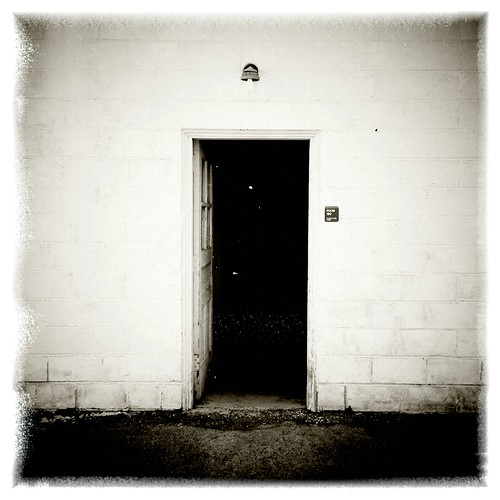
© 2010 Simon Hucko
Another Droid shot this week. I had big plans to go to the Ithaca Festival last Friday and shoot, but instead I met up with a few people and just walked around. I did take a few shots, but nothing outstanding. It was more fun just to be there in the moment, and it's nice to take a step back from the lens from time to time and just enjoy life around you. There are a few other festivals/fairs going on this summer that I plan on shooting (might even break out a roll or two of Tri-X), so look for that.
My shot this week was part of a short walk I took focusing on doors. I've never been one for photo assignments (for whatever reason), but when I got my Droid I got invited to a weekly Android assignment group. I think these weekly assignments are perfect for the walks I take on my lunch break - by this point I've shot most everything within walking distance of my building, so having something different to focus on while I'm wandering around is a great way to spice up the usual routine. If you're in a bit of a rut or have a hard time coming up with photo ideas, I highly recommend an assignment group on flickr (just do a search for "assignment," there must be hundreds to choose from).
My pick this week is "self" by irv_b:

© irv_b
What a great twist on a self-portrait (it even has sort of an Alfred Hitchcock vibe to it). I like that there's just enough light on the background to give a nice crisp silhouette, but no more than necessary. I like your choice of framing, too - the negative space balances it out very well. Very mysterious shot.
That's it for this week. Keep up the great work everyone, we're almost to the half-way point!
~S
[title of blog] on flickr
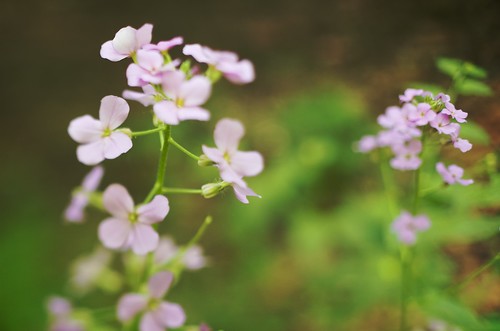
© 2010 Simon Hucko
I first became aware of freelensing a few months back when photojojo published an article about it. It seemed pretty cool, and in the wake of all the tilt-shift photos online (especially the time lapse stuff) I thought I'd give it a try. Unfortunately, I just wasn't able to get images that I was happy with. Last week, photographer friend Tim Ho posted a shot that renewed my interest in freelensing. (side note: if you've never seen his work I highly recommend checking out Tim's photostream. He's got a great eye, especially for color, and is becoming quite an accomplished strobist.)
OK, back it up a bit. What is freelensing? Freelensing is the art of shooting through a lens that isn't attached to your camera. The main reasons to freelens are to create a tilt-shift look with your photos, or to get closer focusing for macro shots. The latter is the same as using an extension tube or bellows, it allows you to get closer to the subject resulting in a larger image on the sensor. The tilt-shift goodness is really what I was after, and considering a tilt-shift lens costs mega bucks, doing it for free seemed like a pretty sweet deal. After doing a little reading, I realized that my earlier failures were due entirely to user error (of course). The key to freelensing is to focus your lens to infinity and keep it *as close as possible* to the camera. In other words, put the lens on the camera like you were going to mount it, but don't twist it in to lock it. Then ever so slightly begin tilting the lens and watch the plane of focus move around. Once you get an image you're happy with, shoot, rinse, repeat.
A few caveats:
1. Your lens is not attached to your camera. This can result in damage to your lens, the mirror, or the sensor, and will probably attract a bit of dust into the camera body. Do this at your own risk.
2. If your lens has an aperture ring, you're all set. If you shoot Canon, stop your lens to the aperture you want by holding down the DOF preview button while removing your lens. If you shoot Nikon, you're going to have to physically hold open the aperture lever on the back of your lens. A small piece of folded up paper, a broken up match stick, or even blue sticky-tack can be used. Be extremely careful when messing around with your lens. Again, this isn't the safest thing in the world...
3. Exposure is going to be all manual, all the time. Your histogram is invaluable for this sort of thing. Learn to love it.
4. Getting what you want in focus is rather difficult at first. Take plenty of shots, and be patient with it. You can even mount your camera to a tripod, making it easier to manipulate the lens without throwing everything off.
5. Longer lenses work better, apparently. Don't ask me why. My 50mm worked really well for this (especially because it has an aperture ring), so that would be my recommendation.
That's about all I can think of. It's another fun little "trick" that can give you some interesting results. I highly recommend playing around with it a bit (as long as you aren't squeamish about shooting with a detached lens), see what you get. Feel free to share your results here or in the [tob] flickr group.
For more discussion on freelensing and some awesome photos, check out the freelensing group on flickr.
~S
[title of blog] on flickr
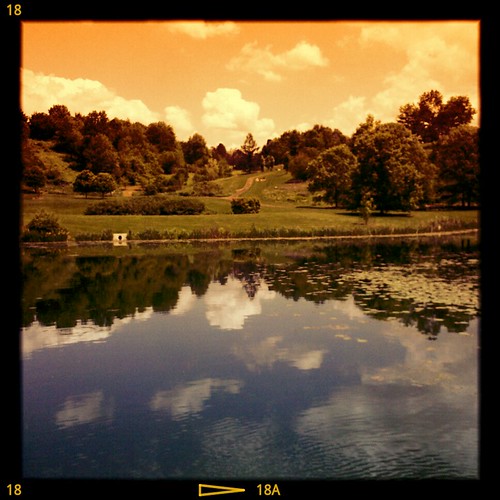
© 2010 Simon Hucko
Well, I gave myself an extra day and I *still* missed my deadline. Sorry everyone. I promise I'll get back into the groove with this whole blog thing soon.
In case you missed the review, I got a new toy last week. As such, I've been shooting an awful lot on it. (I did take the bigboy camera out and play with freelensing a bit, but that's a discussion for another day...) Camera apps for Android are still somewhat limited, but Vignette came highly recommended on the internets and I have to say, it rocks my world. All the low-fi fun you could ever want right at your fingertips. This week's photo was made using a "tobacco" gradient filter, which gives your skies a dramatic orange tint. I really like the effect combined with the water at the bottom of the frame, and I have some killer shots in mind for this effect in the future.
This week's pick is "Strike" by irv_b:
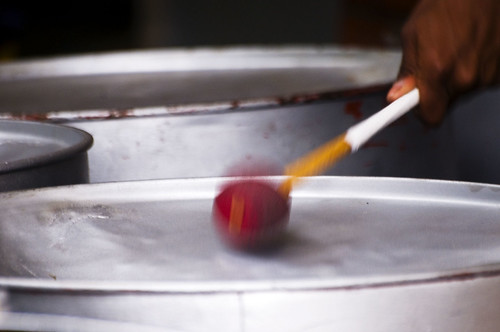
© irv_b
I'll admit, I have a bit of a thing for detail shots of hands at work. This one is very well executed, though - it definitely tells the story of what's going on. The little bit of motion blur is excellent, adds a nice dynamic feel to the photo and you can almost hear the sound of the drum. This would be perfect for some sort of promo material for the band (flyer, program, etc). Great eye and timing.
Ok, that's it for this week. I promise I'll get my act together here and start posting on time again. Keep on shooting!
~S
[title of blog] on flickr
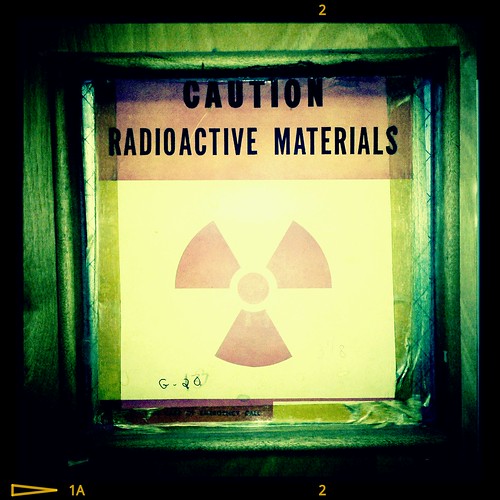
© 2010 Simon Hucko
What? A phone review? Sorry everyone, just got a new toy and I felt like sharing my thoughts about it (especially as it applies to being a photographer). If that's not your cup of tea, feel free to move on. For the rest of you...
My wife and I finally upgraded to smartphones last week. Originally we were talking about switching to AT&T and getting iPhones, but we wound up staying with Verizon and getting matching Motorola Droids. The main reason for this decision was that they were on sale, buy one get one free. Hard to argue with a $200 savings. Another reason that we stuck with Verizon is that we didn't have to wait for our contract to expire next month to avoid paying a fee. Finally, my wife wanted a phone with a physical keyboard - she has an iPod touch and doesn't like typing on it. (I've found that I use the virtual keyboard 99% of the time, but sometimes it's nice to have physical keys to press.)
I was worried I would be unhappy with Android and wish I had held out for an iPhone, but thankfully that's not the case. It still feels a little rough around the edges (especially when it comes to app availability and quality), but the fact that Android is gaining marketshare every day means that the playing field should level out pretty quickly. The important apps are all there, including highly integrated twitter and facebook apps that can sync up with your address book. You also get the option of sharing out photos to twitter or facebook (among other sites) right from the gallery on the phone, which is nice. One thing that's seriously lacking is a good flickr app (at least, I haven't been able to find one). I had to resort to using the e-mail uploading for flickr, which isn't all that bad (especially because "e-mail" is one of the sharing options in the photo gallery), but it's certainly not ideal.
The camera on this phone seems to be pretty good. There are a few nice features missing that I would have liked to see. The most critical lapse is the lack of any kind of exposure adjustment. From what I can tell, exposure compensation is available in the API, so I'm not sure why it hasn't been implemented (maybe the camera doesn't support it?). I hope that they fix this at some point, since the auto-exposure algorithm seems to be a little aggressive and deals with high contrast scenes by blowing out highlights, which is usually the opposite of what I want. 5MP seems a bit extreme, too, I can only imagine how small the photosites are (which leads to lower dynamic range and higher noise). Low light performance is poor, as expected, but the built in LED "flash" is a nice feature. The light is very harsh and a little cool (blue), but it's better than being stuck without one. The camera does auto-focus pretty well, but you're stuck with whatever it thinks you want. A touch to focus feature would be great. The "macro" focusing gets pretty close (within 2 inches or so), which is fun to play with.
I bought Vignette (the only non-free app I have on my phone) to use instead of the stock camera app, and dang is it good - fully functional camera controls plus a ton of framing and filter options for after you take the shot. The app generates a small preview that you can try different looks on until you find the one you like, then processes and saves the full version in the background once you're done. You can even import old photos from your gallery to edit. The only drawback I've found is the inability to stack the different filters. For some reason, there is a small set of options that you can toggle on or off to "stack," but for everything else you have to process the photo with one and then re-import it and process it with another to get a stacking effect. Certainly not a deal breaker, but it would be a nice update.
Overall, I'm very happy with my new phone. The glossy screen (hard to see in direct sunlight) and limited camera controls mean that it won't be completely replacing my point n shoot, but it's nice to have a camera with me 24/7 and a way to share images with everyone instantly. If you're a photographer and haven't gotten a smart phone yet, don't feel like you have to get an iPhone. Android is very photographer friendly, and while it doesn't quite rival the iPhone, it definitely gets the job done. Look for more competitive features in future updates, too.
edit: Forgot to mention the screen. I believe it's something like 854x480, which means that widescreen 480p video will display at its native resolution (and looks really really nice). The wide aspect ratio makes viewing photos a little goofy, but it would be easy for me to upload a set to Picasa that's formatted for the screen. (Forgot to mention that, too - Piacasa integrates with your gallery so that all of your Picasa web albums are available on your phone instantly). The high gloss finish isn't ideal for bright sunlight and shows the smudges from your greasy fingers like nothing else, but I just keep a small microfiber cloth in my pocket to clean the screen and camera when necessary.
~S
[title of blog] on flickr


![[title of blog]](https://blogger.googleusercontent.com/img/b/R29vZ2xl/AVvXsEhJ8bvx_9_zOAREbXcrJRML7aVvJMbb90IYYYuyti384jeZHYQ9t8MK6_Kpt_1P4-pZw-QfF9kh4Sqci0vbopzLme862PPhuyPJcc7pRLUW1K1aNzts5YzuXIhgonq66MpjJCqfiWtfwUw/s1600-r/waterfall.png)











